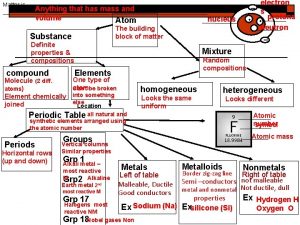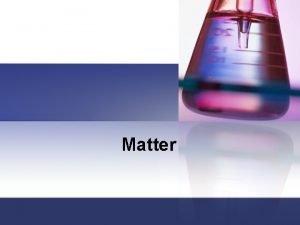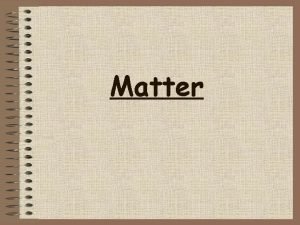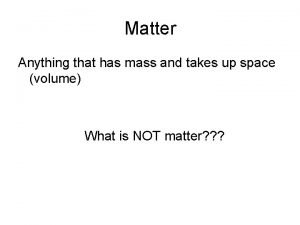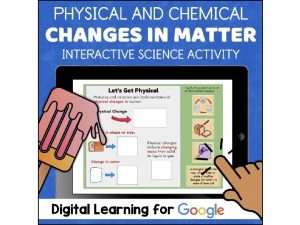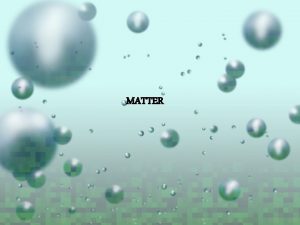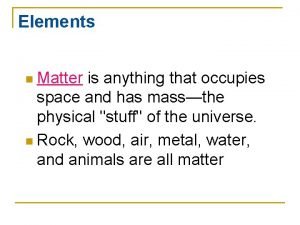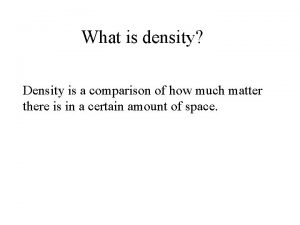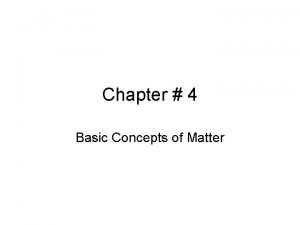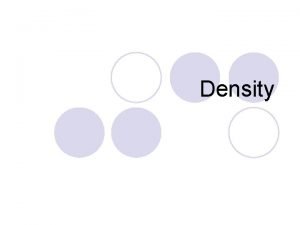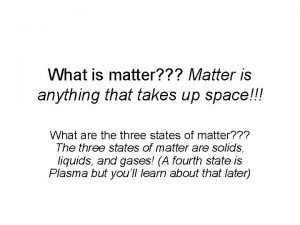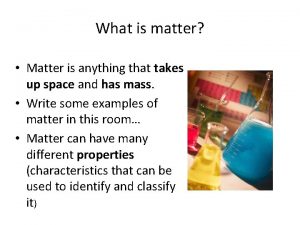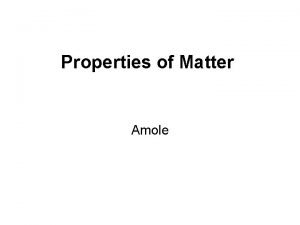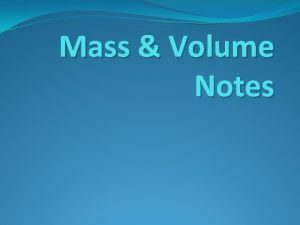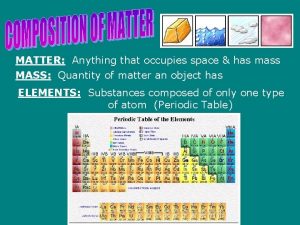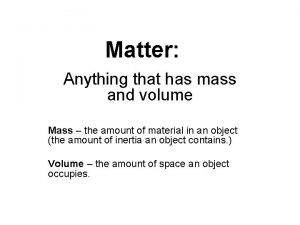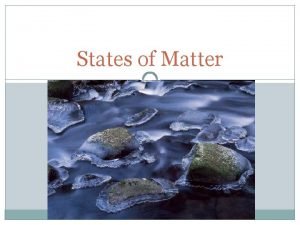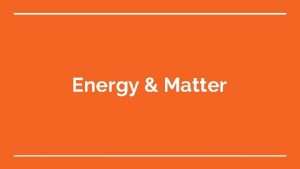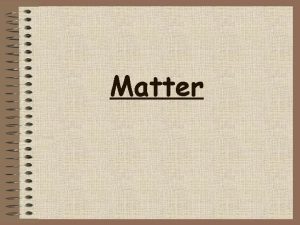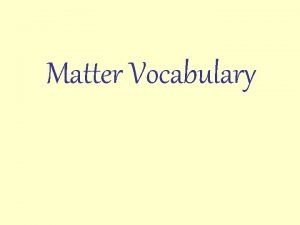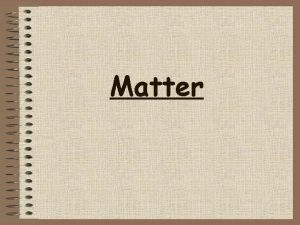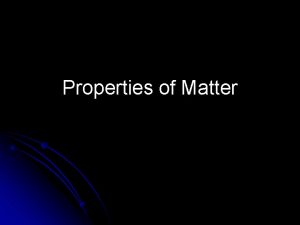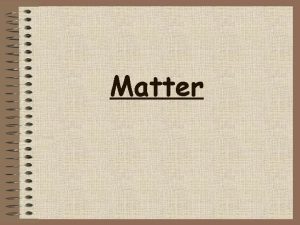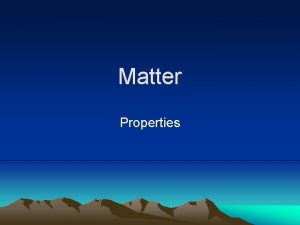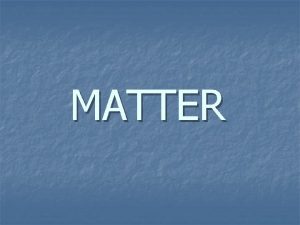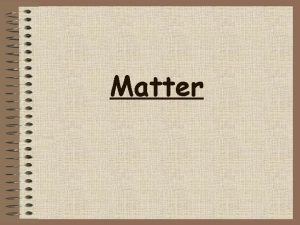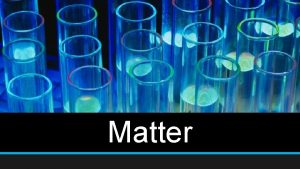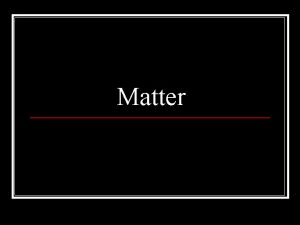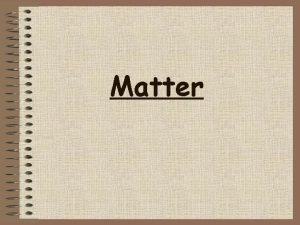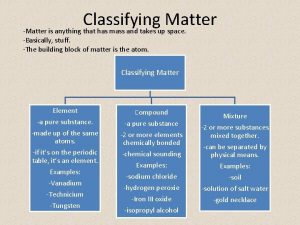Chapter 2 Matter Matter Anything that has mass

































- Slides: 33

Chapter 2 Matter

• Matter: Anything that has mass and takes up space • Atom: is the basic unit of matter • Mass: is the amount of material an object has (do not confuse with weight) • Chemistry: is the study of matter and how it changes • Element: is a substance that cannot be separated into other kinds of substances (lead into gold)





• Physical Property: is a characteristic of a substance that can be observed without changing the substance into a different substance (ice/liquid water/steam) • Compound: is a substance made up of atoms of different elements • Molecule: is the smallest particle of a substance that has the all the properties of the substance • Chemical Property: is a characteristic that describes how a substance changes into a different substance (elements combine with each other in chemical reactions) • Chemical bonds: store energy

Compounds

Chemical Formula • Represents compounds • Example: – Molecule of indigo Dye for blue jeans • C 16 H 10 N 2 O 2 – Three molecules of table sugar • 3 C 12 H 22 O 11

Pure Substance • A sample of matter, either a single element (O) or a single compound (H 2 O), that has definite chemical and physical properties – Elements: Na or Cl – Compound: Na. Cl • Elements and compounds are pure substances, but mixtures are not.

Mixtures • Classified by how well the substances mix – Heterogeneous: mixture that is NOT evenly distributed • Salad – Homogeneous: mixture that is evenly distributed • Vinegar and water • Gasoline (hundreds of liquids that are miscible) • Carbonated beverage


Mixture

Properties of Matter • Physical: characteristics that can be observed without changing the identity of the substance – Density – Melting point (solid to a liquid) – Boiling point (liquid to a gas) – Reactivity (chemical property) • Can be separated by physical means



Density • Ratio of the mass of a substance to its volume • D = mass/volume = m / v





Chemical Property • Reactivity: the capacity of a substance to combine chemically with another substance • Describes how a substance changes into a new substance, either by combining with other elements or by breaking apart into new substances – Flammability (ability to burn) – Iron and oxygen yielding rust – Na and Cl yielding salt (Na. Cl) • Some are reversible – Example of carbonic acid in soda



Changes of Matter • Physical change affects one or more physical properties of a substance without changing the identity of the substance – Melting of ice (solid to liquid) – Crushing of a can – Dissolving of sugar in water – Dissolving of CO 2 in water – Dissolving of air in ice cream (soft ice cream)





Changes of Matter • Chemical change happens when one or more substances are changed into entirely new substances that have different properties (new substance has formed). – Digesting of food • Burn with oxygen – Na and Cl to form Na. Cl – Iron rusting – Copper turning green



 Mass and occupies space
Mass and occupies space Matter is anything with mass and volume
Matter is anything with mass and volume Matter is anything that?
Matter is anything that? Anything that has mass and take up space
Anything that has mass and take up space Matter is anything that occupies space
Matter is anything that occupies space It is anything that has mass and occupies space
It is anything that has mass and occupies space Matter has mass and occupies space
Matter has mass and occupies space Anything that has mass and take up space
Anything that has mass and take up space Whats the basic unit for mass
Whats the basic unit for mass Anything that has mass and takes up space is
Anything that has mass and takes up space is What are the 7 diatomic elements
What are the 7 diatomic elements Matter is anything that has
Matter is anything that has Anything that takes up space and has mass
Anything that takes up space and has mass Matter defintion
Matter defintion Anything that takes up space
Anything that takes up space Matter is anything that
Matter is anything that Phân độ lown
Phân độ lown Block nhĩ thất cao độ
Block nhĩ thất cao độ Thơ thất ngôn tứ tuyệt đường luật
Thơ thất ngôn tứ tuyệt đường luật Thơ thất ngôn tứ tuyệt đường luật
Thơ thất ngôn tứ tuyệt đường luật Chiến lược kinh doanh quốc tế của walmart
Chiến lược kinh doanh quốc tế của walmart Tìm độ lớn thật của tam giác abc
Tìm độ lớn thật của tam giác abc Con hãy đưa tay khi thấy người vấp ngã
Con hãy đưa tay khi thấy người vấp ngã Tôn thất thuyết là ai
Tôn thất thuyết là ai Gây tê cơ vuông thắt lưng
Gây tê cơ vuông thắt lưng Sau thất bại ở hồ điển triệt
Sau thất bại ở hồ điển triệt Density of golden syrup g/cm3
Density of golden syrup g/cm3 Matter is defined as anything that
Matter is defined as anything that Matter anything that
Matter anything that Use of density
Use of density Ionized matter
Ionized matter Matter is anything that:
Matter is anything that: No matter anything
No matter anything Matter is anything that
Matter is anything that

